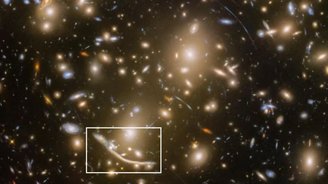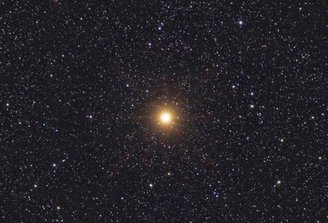Observing stars in the distant universe (regions beyond 5 billion light years) is a nearly impossible task for many astronomers. The first is that the apparent brightness of stars decreases absurdly with distance. Additionally, because the expansion of the universe produces a phenomenon called redshift, which lengthens the wavelength of light, taking it out of the visible spectrum.
However, “thanks to a cosmic quirk of nature”, an international research team led by astronomers from the Steward Observatory of the University of Arizona in the US managed the feat of observing more than 40 stars at a redshift of 0.725; red indicates the objects are approximately 6.5 billion light-years away from Earth.
The discovery, published in the journal Nature Astronomy, sets an absolute record for the largest number of individual stars detected in the distant universe. The galaxy called the Dragon’s Arc is also an opportunity to investigate one of the universe’s greatest mysteries: dark matter.
Examining the Dragon’s Arc through gravitational lensing
The discovery of the bright stars of the Dragon Arc happened somewhat by chance. A press release states that then-postdoctoral researcher Fengwu Sun of the University of Arizona “stumbled upon a trove of such stars” while examining images from the James Webb Space Telescope (JWST).
This surprise is justified, as the Dragon’s Arc galaxy, in addition to being very far from Earth, is located behind a massive galaxy cluster called Abell 370. Fortunately, this cluster’s gravity warps the spacetime around it. Creates a natural lens that amplifies and distorts the light of galaxies behind it.
Although the effect of gravitational lensing was predicted by Albert Einstein in 1915 as part of his General Theory of Relativity, only recently have advances in astronomy allowed the theory to be observed in practice. This phenomenon stretched and distorted the images of the observed galaxy like funhouse mirrors that distorted the images.
How does gravitational lensing magnify images?

The current study, led by Yoshinobu Fudamoto of Chiba University in Japan, was able to identify 44 individual stars in the Dragon Arc. This represents a significant advance in the study of distant galaxies. It’s like evolving from completely blurry vision to seeing the details of every star in the galaxy.
“To us, very distant galaxies often appear as a fuzzy, indistinct blur. But in fact, these dots are composed of many individual stars. We cannot resolve them with our telescopes,” according to Fudamoto.
Dragon’s Arc photos were taken by JWST in December 2022 and 2023. In these images, astronomers had to track 44 stars as their brightness changed over time due to changes in the gravitational lensing landscape. Co-author Fengwu Sun of the Harvard-Smithsonian Center for Astrophysics says it’s possible to make such observations “as long as nature is there to help.”
Color of Dragon Arc’s stars

The team performed a careful analysis, as it provided information about the colors, temperatures, and types of each of the stars discovered in Dragon’s Arc. Studies have shown that most of them are red supergiants, large and cool stars in the final stages of their lives, such as the famous Betelgeuse in the constellation Orion.
This contrasts with earlier studies of distant galaxies that identified very hot, young stars and often blue supergiants, such as Rigel (also in Orion) and Deneb (in the constellation Cygnus). These stars are among the brightest stars in the night sky. This difference highlights JWST’s potential to study stellar objects at lower temperatures in previously unattainable detail, the researchers say.
The authors’ expectation is that future JWST observations will capture more magnified stellar objects in the Arco do Dragão galaxy. This will theoretically allow us to study hundreds of stars in very distant galaxies. The aim is not only to better understand the composition, evolution and properties of these objects, but also also to obtain data on the structure of gravitational lenses and insights into the nature of dark matter.
Was the material clear enough? Tell us about our social networks and get the opportunity to share it with your friends who also enjoy great topics. Until later!
Source: Tec Mundo
I’m Blaine Morgan, an experienced journalist and writer with over 8 years of experience in the tech industry. My expertise lies in writing about technology news and trends, covering everything from cutting-edge gadgets to emerging software developments. I’ve written for several leading publications including Gadget Onus where I am an author.











